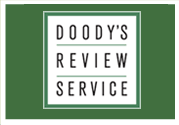|
When Doody's Journal launched in 1993, it was based on the premise that a comprehensive source of health sciences book reviews would be a time- and cost-saving resource for medical librarians. Indeed, other book review services such as ALA's Booklist and Choice had already long-established the market opportunity and business model for such services aimed at libraries. It was a matter of introducing medical librarians to an alternative (or, perhaps, complement) to the expert reviews published in health sciences journals.
Though today's digital databases allow users to easily search for book reviews across hundreds of journals in aggregate, the novelty of a one-stop resource dedicated specifically to expert reviews of health information resources persists. Doody's Collection Development Monthly (DCDM) is a testament not only to this persistence but to the value of expert reviews to various groups within the health information community. In this piece, I want to reflect on this value, especially when considering DCDM and its content as a collective resource.

A library collection. Image credit: BartokFan
The value of resource reviews in aggregate
As Doody's primary audience, our platforms’ content is designed by and for librarians. Reading (and to a lesser extent, writing) reviews is a fundamental task of librarianship. This may seem like a futile point to make, especially in an age of seemingly incessant demands for customer reviews of everything from household appliances to the latest streaming series. However, expert or editorial reviews allow librarians to quickly and easily assess a resource’s necessity for their collection, or to determine the extent to which a resource might be evaluated for acquisition.
Each review, whether of a book or a digital resource, has unique value to members of the health information community. Librarians read these reviews for information about resources to add to their collection. Practicing health professionals read reviews to scope out new or updated resources in their field that they may use to improve their practice. Educators use reviews to determine which materials to use for teaching future health professionals. The authors and editors of reviewed resources turn to these appraisals for feedback on what went right and sometimes what didn't; they may even gather intelligence about competing titles. Similarly, health sciences publishers scan reviews for potential improvements to future editions or to similar works. Booksellers and content aggregators engage reviews to ensure they're organizing resources into lucrative packages for sale or subscription.
Taken in aggregate, however, reviews offer health information community members an awareness of the information landscape and the resources available to them. By "aggregate," I don't mean collecting all the reviews of a single resource in one place as you might find on a product's point-of-sale page. Rather, I am referring to collecting reviews of information resources in one spot for ease of access and comprehensive coverage.
Doody's Review Service (DRS), the current-day electronic version of Doody's Journal, is an excellent (I know - I'm biased!) example of such a collection. It's here we publish reviews, written by experts in the field, of newly published health sciences books. To date, DRS has amassed over 44,000 book reviews and is regarded as a premier source of timely, objective information about health sciences books. Each review is mostly dedicated to spelling out basic information about a book, ideally in greater depth than what could be found by researching the resource independently. Still, each review does include an evaluative assessment section.
DRS not only facilitates access to valuable assessments of books but also to objective information on thousands of books published across time. For those reasons, DRS serves as an indicator of where health sciences book publishing has been, where it's going, and what topics emerge (or re-emerge) as prominent in our collective health sciences conscience.
Alternatively, DRS can be a reference for surveying the types of books, publishers, subjects, and experts that populate the health sciences book publishing terrain. Readers become familiar with the publishers and thinkers active in their areas of interest and learn about the general and niche texts that are commonplace among library shelves. They gain an understanding of various book types and, through reading reviews, come to appreciate each type's utility for specific audiences.
Re-examining DCDM as a collective whole
It's with this comprehensive lens that I’d like to examine DCDM as a digital resource all its own. Launched in 2014, DCDM, the platform you’re on right now, is a monthly blog and newsletter that features, among other content, reviews of digital resources written by librarians, for librarians.
Taken as a whole, the variety of content available at DCDM makes it an outstanding site (again, I own my bias!) for quickly and easily surveying health sciences information resources. DCDM offers reviews on over 80 electronic resources used in medical libraries across the U.S. and other parts of the world. DCDM also includes introductory information on health sciences book publishers and specialty areas, which highlight core titles, publication numbers, and general pricing trends. DCDM features profiles of Doody’s librarian and health professional volunteers, which serve as informal introductions to the “who’s who” in the health information community.
In January 2018, we began inviting reviewers to update their original DCDM reviews. Not only did this initiative respond to reader demand for updated information on important digital resources, but it also represented a significant editorial divergence from our DRS book review publishing model. Both DCDM digital resource reviews and DRS book reviews follow structured, guided formats that are largely focused on objective details of the resource or book. In both instances we publish one expert's opinion at one point in time. DCDM review updates, however, go a step further to explicitly address the ever-changing nature of digital resources. Though enhanced ebooks are challenging the static nature of book content, it is still widely accepted that a book's content is not updated until a new edition is published, at which time a new book review is merited. The same cannot be said for electronic resource content, which can be and often is updated frequently. (For those who may baulk at my treatment of book reviews, please know it does not escape me that review updates of books may cast new value or perspective on a resource's applicability in shifting contexts and fields. Alas, that's a conversation for another time.)
So, what’s the value of considering DCDM content, especially the reviews and review updates, in aggregate? Any librarian working with collections will presumably already be keeping abreast of reviews for their work. But for a librarian who has newly acquired collections or electronic resource management responsibilities or for a librarian who is moving into the health sciences from a different area, DCDM can be a starting place for learning about resources unique to the health sciences. I’m proud that DCDM reviews encompass a wide variety of well-known general resources (e.g., LWW Health Library, AccessMedicine), specialty-specific resources (e.g., Dentistry & Oral Sciences Source, Human Kinetics Library), and openly available content (e.g., PEDro). DCDM may also enable libraries with limited budgets and time to sharpen their efforts aimed at acquiring or trying out new resources. For library school students interested in pursuing health sciences librarianship, DCDM can offer a concise overview of the types of resources with which they may want to familiarize themselves or the types of information needs a health sciences librarian helps solve (I’d personally love to see an iSchool LibGuide that included DCDM as a health sciences or collection development resource!). In each instance, DCDM provides a critical, synthesized awareness of a broad array of resources and information that would otherwise be decentralized.
Limits & conclusions
Certainly, there are limitations to considering DCDM as its own collective digital resource. First, DCDM’s search functionality and organizing system are what one might expect of a blog, and don’t quite meet library standards. While DCDM covers electronic resources in detail, there is no intentional discussion or review of specific academic journals, one of the most important collection development considerations for today’s health sciences libraries. And when publishing a certain amount of content only once a month (hence the Monthly), it may take DCDM longer to include timely reviews of trending digital resources.
Even embracing these limitations, there is much opportunity in considering DCDM as its own whole resource. The potential for impact on the library landscape appears greater when DCDM is considered for more than just its individual reviews but for its utility when its component parts coalesce. Envisioning it this way uncovers that which is DCDM’s greatest accomplishment: becoming a robust, complete resource it was not originally conceived to be. In the future, I hope DCDM continues to grow as a portal for affordable and continual awareness, learning, and insight into health sciences information ecosystem. Thank you for being part of its journey!
This article was written by Tim Butzen, Chief Operating Officer of Doody Enterprises.
More DCDM-related resources:
|
